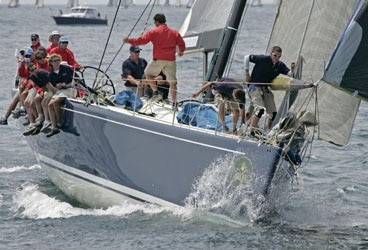
FBBlockIslandSt
Storm Trysail Club Block Island Race Week presented by Rolex is one of the few “week” events, it seems, that actually takes place Monday through Friday. It’s a great format; the weekend before you’ve got time to get out to Block and practice, and the weekend after you’ve got plenty of time to get home and spend some time with the family before returning to work. I think of the two bookend weekends as perfect compression and de-compression periods, respectively. This year, 183 entries sailed on three race circles on Block Island Sound in conditions ranging from glassed-off calm to a blustery southwesterly.From the entry procedure through the final awards ceremony, Block Island Race Week runs like a well-lubricated bit of complex machinery. Most of this efficiency is due to the staggering number of STYC volunteers, which, this year, included 28 members on the shoreside committee, 61 on the various race committees, and 13 on the jury. Unlike some volunteer-run events I’ve attended in the past, BIRW seems to go off like clockwork, especially on the water. Thanks to the influence of long-time members like Arthur “Tuna” Wullschleger, the on-the-water racecourse management is excellent. Principal Race Officers of each fleet used the “open-mike” method of communicating with the racers via VHF, updating them with information prior to the first gun, providing information on what they’re seeing and thinking during postponements, and counting down to all signals. Compared to a method used by a committee from another club at a regatta I sailed a few weeks before, the BIRW committee’s starting procedure was a vast improvement. The RC for the previous regatta would sound a blast while hoisting a signal, then, a few seconds later, imperiously announce: “That was the prep signal for Class One.”While the BIRW committee excelled in getting races off, their shining moment didn’t come until the final day on the water, when a sailor racing on the Red Fleet’s circle began exhibiting all the symptoms of a heart attack or stroke. Within a few short minutes, Red Fleet PRO Wayne Bretsch, a member of the Chesapeake Station of STYC, had tasked his mark boat to the scene, helped coordinate other chase boats to the ill sailor, alerted the town of New Shoreham’s EMT squad, and passed on all vital information to those who needed it. The stricken sailor was first taken off his raceboat and on to a RIB skippered by marine photographer Peter McGowan. A few short minutes later, a larger RIB, the tender for John Brim’s new Rima2, arrived on scene. After determining that the Rima2 tender, skippered by Jim Condon, would be a better, faster platform in the lumpy conditions three miles west of the Island, the sailor was loaded aboard and taken at speed into Block Island’s Great Salt Pond. Just before leaving the scene, the Rima2 tender was told by Bretsch that they were to “make all speed through Great Salt Pond to meet the EMTs.” They picked the right tender; even loaded with spare gear and sails, the Rima2 tender was able to hustle the patient landward quickly, despite the big chop we were sailing in that day. According to witnesses on Great Salt Pond, the tender came through the “no wake,” “5 m.p.h. max speed” harbor at around 50 knots.In the end, good news prevailed. The sailor hadn’t suffered a heart attack or a stroke, and didn’t require hospitalization. It was, however, a fine example of how the BIRW/STYC committee members had planned ahead for such incidents, and were able to execute that plan flawlessly.The racing was great, too. After a couple hours of light air postponement on Day 1, most classes got one race off, and some scored two. On Day 2, we raced around the Island on a 16-mile course notorious for its current and wind shear challenges. The small boats started first and enjoyed a great view of the monsters of the fleet, such as Tom Hill’s 75-foot Reichel/Pugh Titan XII and Bob and Farley Towse’s 66-foot Reichel/Pugh Blue Yankee, as they sailed by. Day 3 was a full schedule of windward/leeward racing in fog and rain, and on Day 4 Block Island Sound showed the fleet its best-strong, gusty southwesterlies–and we sailed more windward/leewards. The final day of racing was even more breeze-on, with gusts topping out at 28 knots. Blue Yankee won the top award of the regatta, the inaugural Rolex US-IRC National Championship, and the Super Zero class. The mathematical formula for determining Blue Yankee as champion was based on fleet performance, using corrected boat speed, and class competitiveness. Overall winner in PHRF was Kel Weber’s J/34C Rascal, which won class honors by a single point over Paul Pakos’ Swan 44 Xenophon. Winning IRC Zero was Colm Barrington’s IRC racer/cruiser Magic Glove, which sailed an impeccable regatta to both its class and the Governor’s Perpetual Trophy for the foreign yacht with the best performance of the week. For complete results, go to www.blockislandraceweek.com.









